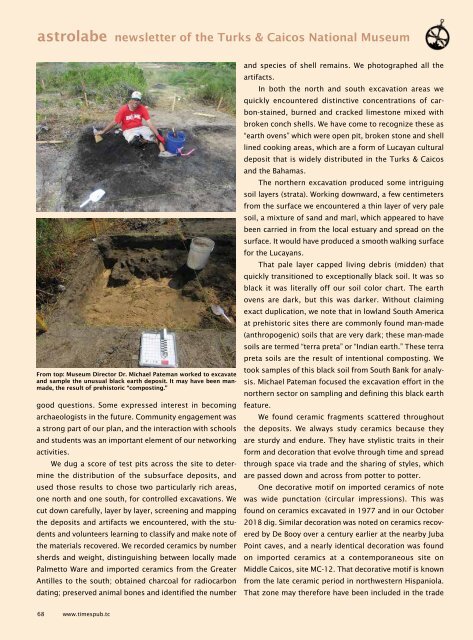Times of the Islands Summer 2019
Presents the "soul of the Turks & Caicos Islands" with in-depth features about local people, culture, history, environment, businesses, resorts, restaurants and activities.
Presents the "soul of the Turks & Caicos Islands" with in-depth features about local people, culture, history, environment, businesses, resorts, restaurants and activities.
Create successful ePaper yourself
Turn your PDF publications into a flip-book with our unique Google optimized e-Paper software.
astrolabe newsletter <strong>of</strong> <strong>the</strong> Turks & Caicos National Museum<br />
From top: Museum Director Dr. Michael Pateman worked to excavate<br />
and sample <strong>the</strong> unusual black earth deposit. It may have been manmade,<br />
<strong>the</strong> result <strong>of</strong> prehistoric “composting.”<br />
good questions. Some expressed interest in becoming<br />
archaeologists in <strong>the</strong> future. Community engagement was<br />
a strong part <strong>of</strong> our plan, and <strong>the</strong> interaction with schools<br />
and students was an important element <strong>of</strong> our networking<br />
activities.<br />
We dug a score <strong>of</strong> test pits across <strong>the</strong> site to determine<br />
<strong>the</strong> distribution <strong>of</strong> <strong>the</strong> subsurface deposits, and<br />
used those results to chose two particularly rich areas,<br />
one north and one south, for controlled excavations. We<br />
cut down carefully, layer by layer, screening and mapping<br />
<strong>the</strong> deposits and artifacts we encountered, with <strong>the</strong> students<br />
and volunteers learning to classify and make note <strong>of</strong><br />
<strong>the</strong> materials recovered. We recorded ceramics by number<br />
sherds and weight, distinguishing between locally made<br />
Palmetto Ware and imported ceramics from <strong>the</strong> Greater<br />
Antilles to <strong>the</strong> south; obtained charcoal for radiocarbon<br />
dating; preserved animal bones and identified <strong>the</strong> number<br />
and species <strong>of</strong> shell remains. We photographed all <strong>the</strong><br />
artifacts.<br />
In both <strong>the</strong> north and south excavation areas we<br />
quickly encountered distinctive concentrations <strong>of</strong> carbon-stained,<br />
burned and cracked limestone mixed with<br />
broken conch shells. We have come to recognize <strong>the</strong>se as<br />
“earth ovens” which were open pit, broken stone and shell<br />
lined cooking areas, which are a form <strong>of</strong> Lucayan cultural<br />
deposit that is widely distributed in <strong>the</strong> Turks & Caicos<br />
and <strong>the</strong> Bahamas.<br />
The nor<strong>the</strong>rn excavation produced some intriguing<br />
soil layers (strata). Working downward, a few centimeters<br />
from <strong>the</strong> surface we encountered a thin layer <strong>of</strong> very pale<br />
soil, a mixture <strong>of</strong> sand and marl, which appeared to have<br />
been carried in from <strong>the</strong> local estuary and spread on <strong>the</strong><br />
surface. It would have produced a smooth walking surface<br />
for <strong>the</strong> Lucayans.<br />
That pale layer capped living debris (midden) that<br />
quickly transitioned to exceptionally black soil. It was so<br />
black it was literally <strong>of</strong>f our soil color chart. The earth<br />
ovens are dark, but this was darker. Without claiming<br />
exact duplication, we note that in lowland South America<br />
at prehistoric sites <strong>the</strong>re are commonly found man-made<br />
(anthropogenic) soils that are very dark; <strong>the</strong>se man-made<br />
soils are termed “terra preta” or “Indian earth.” These terra<br />
preta soils are <strong>the</strong> result <strong>of</strong> intentional composting. We<br />
took samples <strong>of</strong> this black soil from South Bank for analysis.<br />
Michael Pateman focused <strong>the</strong> excavation effort in <strong>the</strong><br />
nor<strong>the</strong>rn sector on sampling and defining this black earth<br />
feature.<br />
We found ceramic fragments scattered throughout<br />
<strong>the</strong> deposits. We always study ceramics because <strong>the</strong>y<br />
are sturdy and endure. They have stylistic traits in <strong>the</strong>ir<br />
form and decoration that evolve through time and spread<br />
through space via trade and <strong>the</strong> sharing <strong>of</strong> styles, which<br />
are passed down and across from potter to potter.<br />
One decorative motif on imported ceramics <strong>of</strong> note<br />
was wide punctation (circular impressions). This was<br />
found on ceramics excavated in 1977 and in our October<br />
2018 dig. Similar decoration was noted on ceramics recovered<br />
by De Booy over a century earlier at <strong>the</strong> nearby Juba<br />
Point caves, and a nearly identical decoration was found<br />
on imported ceramics at a contemporaneous site on<br />
Middle Caicos, site MC-12. That decorative motif is known<br />
from <strong>the</strong> late ceramic period in northwestern Hispaniola.<br />
That zone may <strong>the</strong>refore have been included in <strong>the</strong> trade<br />
68 www.timespub.tc

















